Tom's Hardware Verdict
Ryzen Threadripper 2950X builds on all of the goodness offered by AMD's first-gen Ryzen Threadripper processors, addressing some of our concerns in the process. If you're looking to upgrade from an older CPU to an all-around crowd pleaser, Threadripper 2950X does not disappoint.
Pros
- +
Reasonable price per core
- +
Lots of horsepower packed into 16C/32T configuration
- +
Solid generational performance improvement
- +
Indium solder between heat spreader and dies
- +
Unlocked multiplier for overclocking
Cons
- -
Expensive platform
Why you can trust Tom's Hardware
Introduction
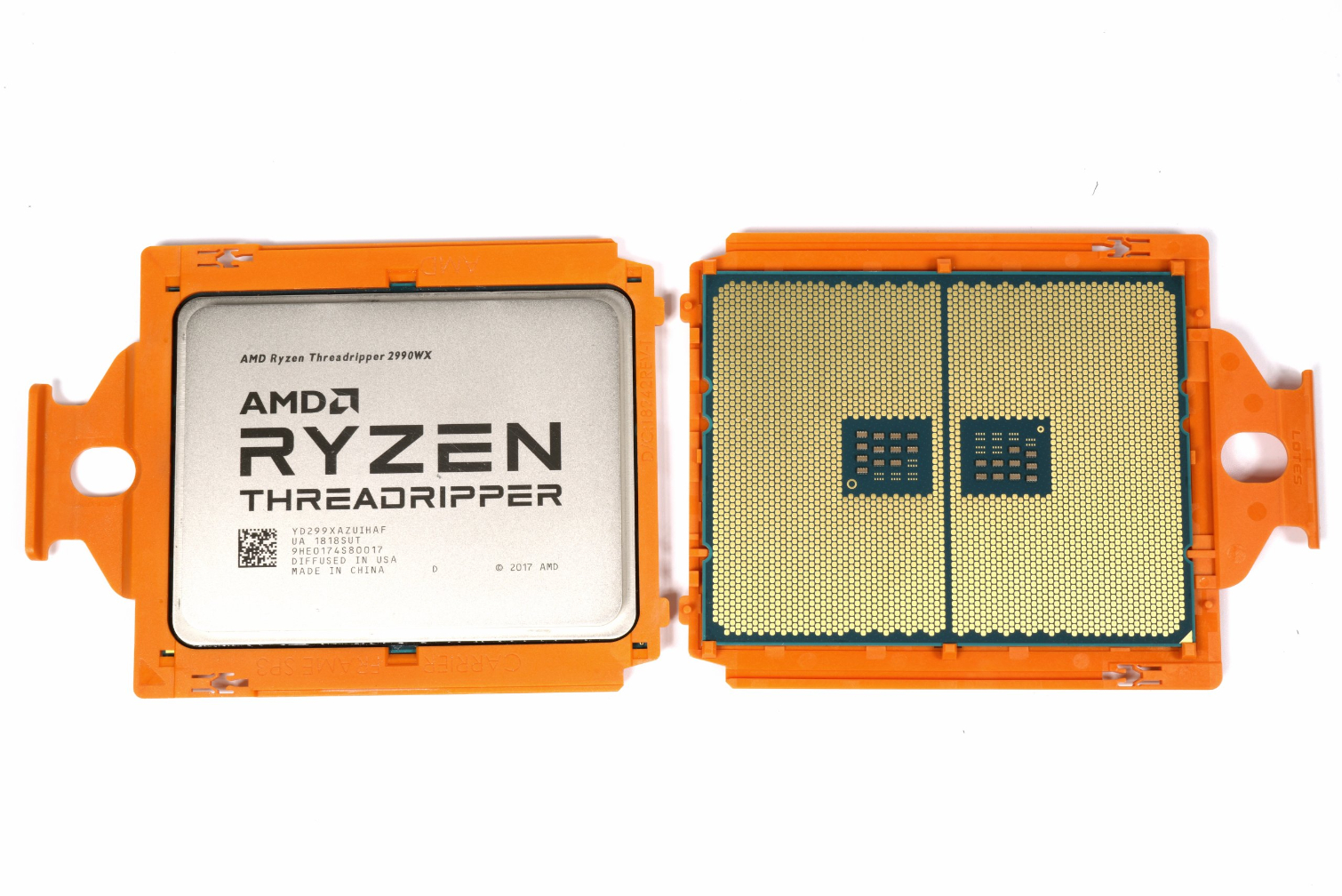
AMD is building on the success of its high-end desktop Ryzen Threadripper processors with a handful of powerful new models known as the Threadripper 2000-Series or, unofficially, Threadripper 2.
The flagship Threadripper 2990WX is an $1800 beast armed with an incredible 32 Zen+-based cores and the ability to work on 64 threads concurrently. Threadripper 2970WX wields 24 cores and 48 threads, plus lower boost frequencies, but also pushes pricing down to $1300. Those are both quad-die configurations. AMD is also updating its dual-die line-up with the Threadripper 2950X, wielding 16 Zen+ cores for $900, and Threadripper 2920X, sporting 12 cores and the ability to work on 24 threads concurrently for $650. The 2950X, specifically, serves up impressive value across a diverse range of workloads. It may very well be the CPU to beat in today's high-end desktop market.
Even though AMD claims its top-end Threadripper 2990WX is up to 51% faster than Intel's $2000 Core i9-7980XE, there are some caveats enthusiasts need to be made aware of. For instance, the WX series' multi-chip module comprises four separate dies. Due to the constraints of AMD's existing Threadripper design, two of the 2990WX's dies aren't connected directly to main memory. That creates an architecture capable of incredible performance in heavily-threaded workloads that aren't sensitive to memory throughput, but less impressive results in bandwidth-hungry applications that don't scale well with extra cores. We found that the Threadripper 2990WX is mostly a niche product for professionals with specific requirements. Still, it sets a new high water mark for compute horsepower on the desktop.
Threadripper 2
Earlier this year, AMD retooled its mainstream Ryzen line-up with new Zen+ optimizations that include 12nm manufacturing, improved memory and cache latency, higher clock rates, and enhanced multi-core Precision Boost frequencies. The net effect of those changes carry over to the new Threadripper models.
And like the previous-gen Threadripper models, AMD offers improved frequency and voltage scaling by selecting the top 5% of Zeppelin dies for its halo product line. That should translate to lower voltage requirements at any given clock rate.
| Row 0 - Cell 0 | Ryzen Threadripper 2990WX | Ryzen Threadripper 2950X |
| Socket | TR4 | TR4 |
| Cores / Threads | 32 / 64 | 16 / 32 |
| Base Frequency | 3.0 GHz | 3.5 GHz |
| Boost Frequency | 4.2 GHz | 4.4 GHz |
| Memory Speed | DDR4-2933 (Varies) | DDR4-2933 (Varies) |
| Memory Controller | Quad-Channel | Quad-Channel |
| Unlocked Multiplier | Yes | Yes |
| PCIe Lanes | 64 (Four to the chipset) | 64 (Four to the chipset) |
| Integrated Graphics | No | No |
| Cache (L2 / L3) | 80MB | 40MB |
| Architecture | Zen+ | Zen+ |
| Process | 12nm LP GloFo | 12nm LP GloFo |
| TDP | 250W | 180W |
With today's introduction, AMD splits its Threadripper portfolio into the WX and X families. Similar to the company's previous-gen X products, the two new WX models are geared toward intense multitasking workloads, 3D rendering, media encoding, and cinema mastering. That makes them attractive to software developers, video/audio engineers, and content creators.
The 32C/64T Ryzen Threadripper 2990WX has a 3 GHz base frequency that stretches up to 4.2 GHz via AMD's XFR (eXtreme Frequency Range) algorithms. It does battle with Intel's $2000 Core i9-7980XE, boasting 18 Hyper-Threaded cores. AMD claims the 2990WX's single-threaded performance only lags the -7980XE by four percent. That's the closest the company has come to matching Intel in this important metric.
AMD also has a $1300 Threadripper 2970WX in the works that serves up 24 cores able to work on 48 threads simultaneously. However, it won't be available until October.
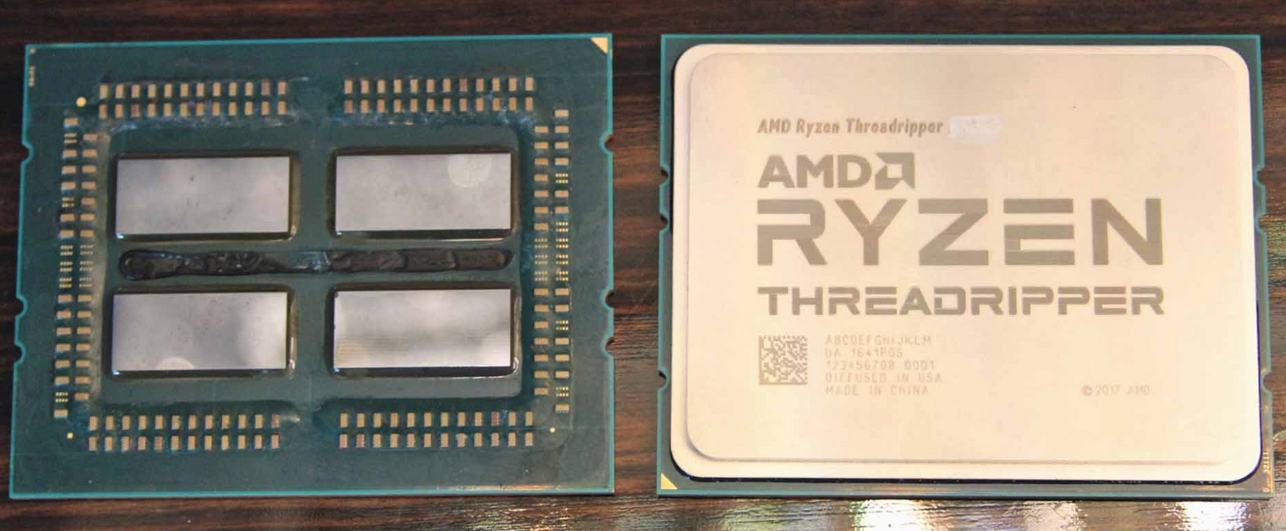
Each of the WX processors' four dies feature eight physical cores and 16MB of L3 cache. Threadripper 2990WX and 2970WX both enjoy the benefit of 64MB L3 cache. However, AMD disables two cores per die on the 2970WX to facilitate its 24-core configuration.
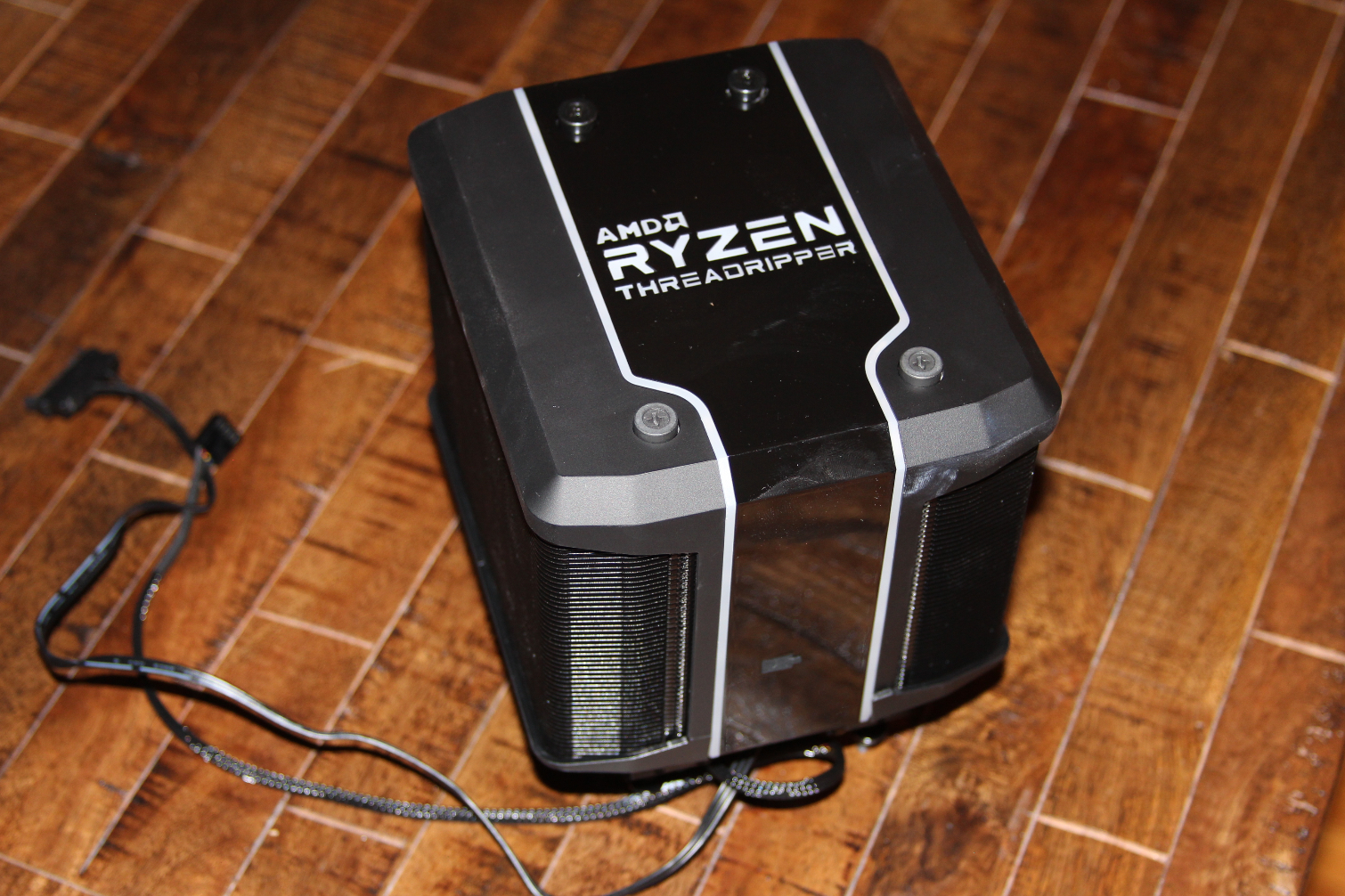
The WX family's more sophisticated layout results in a 250W thermal design power. Of course, that's significantly higher than the original Threadripper's 180W rating, meaning you need a high-end cooling solution to realize peak performance (particularly if you plan on overclocking). AMD ships all Threadripper CPUs with an Asetek bracket that provides partial coverage of the massive heat spreader using supported closed-loop liquid coolers. According to AMD, this partial coverage is fine for stock operation. But we found that full-coverage coolers work better. AMD also collaborated with Cooler Master to develop the Wraith Ripper heat sink/fan combo for its Socket TR4 interface. It's sold separately, though. The premium cooler comes with configurable RGB lighting and was designed to accommodate tall memory modules under its fin stack.
AMD uses Indium solder between its dies and heat spreader to improve thermal transfer. In contrast, Intel employs thermal grease. Intel also recommends liquid cooling on its Skylake-X processors, while, again, AMD contends that air cooling is ample.
| Row 0 - Cell 0 | Cores /Threads | Base / Boost (GHz) | L3 Cache (MB) | PCIe 3.0 | DRAM | TDP | MSRP | Price Per Core |
| TR 2990WX | 32 / 64 | 3.0 / 4.2 | 64 | 64 (4 to PCH) | Quad DDR4-2933 | 250W | $1799 | $56 |
| TR 2970WX | 24 / 48 | 3.0 / 3.2 | 64 | 64 (4 to PCH) | Quad DDR4-2933 | 250W | $1299 | $54 |
| Core i9-7980XE | 18 / 36 | 2.6 / 4.4 | 24.75 | 44 | Quad DDR4-2666 | 140W | $1999 | $111 |
| TR 2950X | 16 / 32 | 3.5 / 4.4 | 32 | 64 (4 to PCH) | Quad DDR4-2933 | 180W | $899 | $56 |
| TR 1950X | 16 / 32 | 3.4 / 4.4 | 64 | 64 (4 to PCH) | Quad DDR4-2667 | 180W | $750 | $47 |
| Core i9-7960X | 16 / 32 | 2.8 / 4.4 | 22 | 44 | Quad DDR4-2666 | 140W | $1699 | $106 |
| TR 2920X | 12 / 24 | 3.5 / 4.3 | 32 | 64 (4 to PCH) | Quad DDR4-2933 | 180W | $649 | $54 |
| TR 1920X | 12 / 24 | 3.5 / 4.2 | 64 | 64 (4 to PCH) | Quad DDR4-2667 | 180W | $399 | $33 |
| Core i9-7920X | 12 /24 | 2.9 / 4.4 | 16.50 | 44 | Quad DDR4-2666 | 140W | $1199 | $100 |
| Core i9-7900X | 10 / 20 | 3.3 / 4.3 | 13.75 | 44 | Quad DDR4-2666 | 140W | $999 | $99 |
| Core i7-8700K | 6 / 12 | 3.7 / 4.7 | 12 | 16 | Dual DDR4-2666 | 95W | $359 | $60 |
| Ryzen 7 2700X | 8 / 16 | 3.7 / 4.3 | 16 | 16 | Dual DDR4-2933 | 105W | $329 | $41 |
Unlike AMD's first round of Threadripper chips, which were aimed at prosumers, this time the company is going after enthusiasts and gamers with its X series. The $900 Ryzen Threadripper 2950X weighs in with 16 cores and 32 threads, but features much higher clock rates than the WX models. The 2950X's 3.5 GHz base frequency and 4.4 GHz boost rate are slight steps up from Threadripper 1950X's 3.4/4.2 GHz specifications. Expect to find Threadripper 2950X in stock on August 31, 2018.
AMD plans to launch the $650 Threadripper 2920X in October. That 12-core, 24-thread CPU will offer a base frequency of 3.5 GHz and a maximum boost clock rate of 4.3 GHz. As with previous X-series models, the 2950X and 2920X utilize a pair of eight-core dies and two dummy packages that help with mechanical stability as you tighten down a thermal solution. The active dies expose 32MB of L3 cache, and abide the same 180W TDP rating as first-gen Threadripper processors.
All of the new Threadripper chips sport unlocked ratio multipliers for overclocking, along with 60 lanes of third-gen PCI Express (plus four lanes attached to the supporting chipset). All of that connectivity could come in handy for discrete graphics cards for rendering or compute, but they're also useful for high-performance storage and networking.
Threadripper CPUs feature independent dual-channel memory controllers located on two dies, which combine to provide quad-channel support with varying data transfer rates based upon your configuration. With today's introduction, AMD bumps its maximum specification up to DDR4-2933 from DDR4-2666. Today, the platform supports ECC memory and up to 256GB of capacity. However, it can accommodate up to 2TB as memory density increases.
| DIMM Config | Memory Ranks | Official Supported Transfer Rate (MT/s) |
| 4 of 4 | Single | DDR4-2933 |
| 4 of 8 | DDR4-2667 | |
| 8 of 8 | DDR4-2133 | |
| 4 of 4 | Dual | DDR4-2933 |
| 4 of 8 | DDR4-2667 | |
| 8 of 8 | DDR4-1866 |
Precision Boost 2, XFR2, and Precision Boost Overdrive (PBO)
AMD's previous-gen Ryzen processors included features called Precision Boost, a dynamic voltage frequency scaling technology similar to Intel's Turbo Boost, and eXtended Frequency Range, which provided additional frequency uplift if your cooling solution had thermal headroom to spare. Those 1000-series CPUs only offered quad-core (X series) or all-core Precision Boost and XFR clock rates.
The Threadripper WX processor's highest boost frequency occurs on eight cores simultaneously, while the X-series chips boost on four cores. There remains headroom to exploit, though. Precision Boost 2, which debuted on the desktop with AMD's Raven Ridge processors, and XFR2 algorithms improve performance in threaded workloads by raising the frequency of any number of cores. Precision Boost 2 delivers up to 500 MHz-higher clocks during multi-core workloads, while XFR2 adds an additional 16% boost if your cooler is beefy enough.
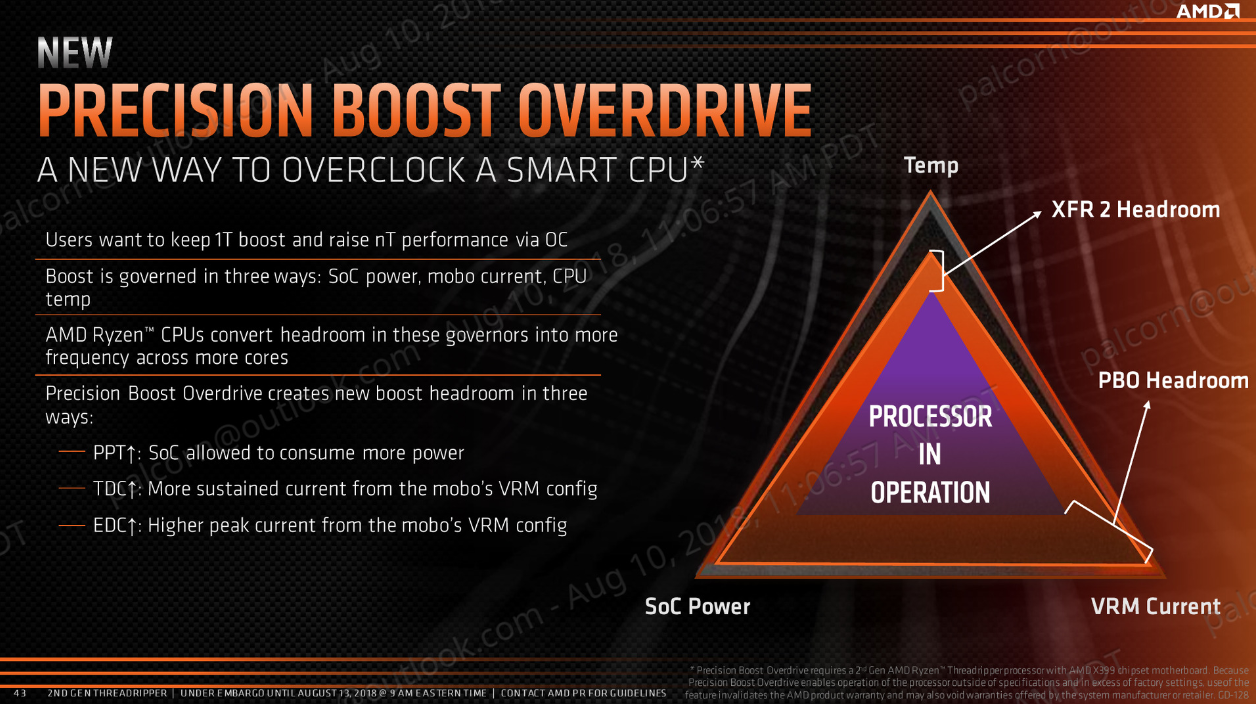
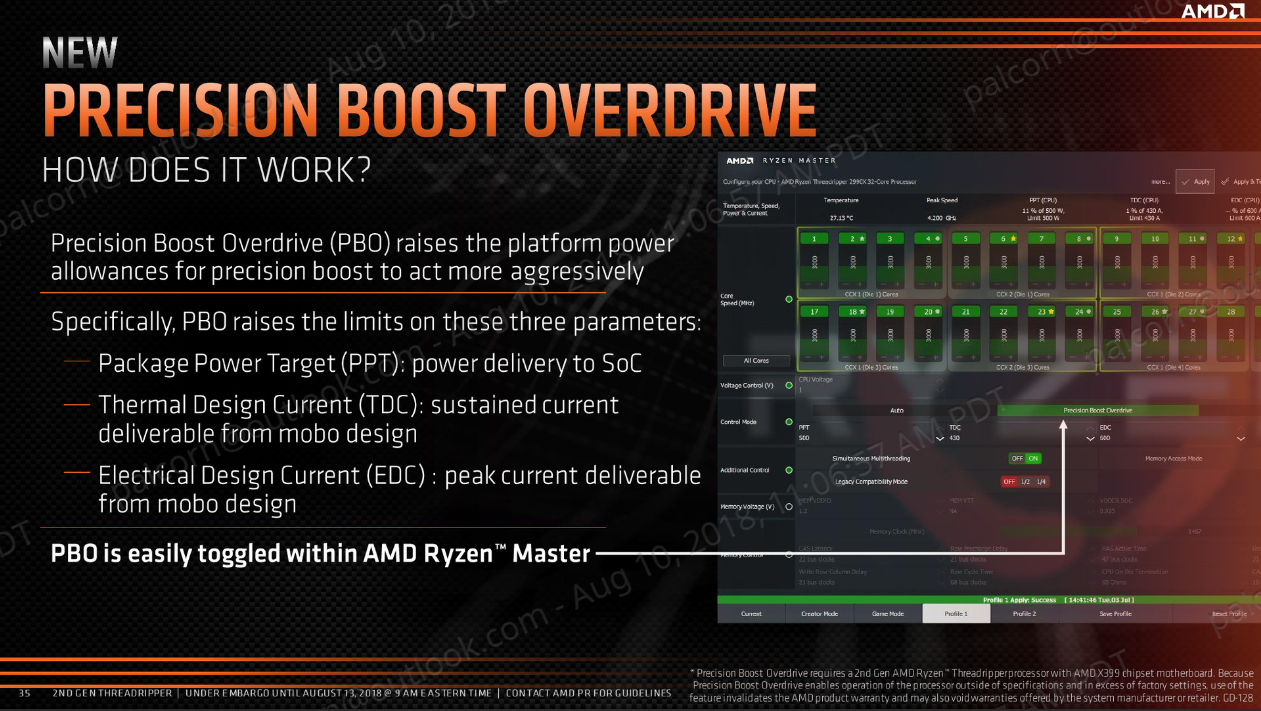
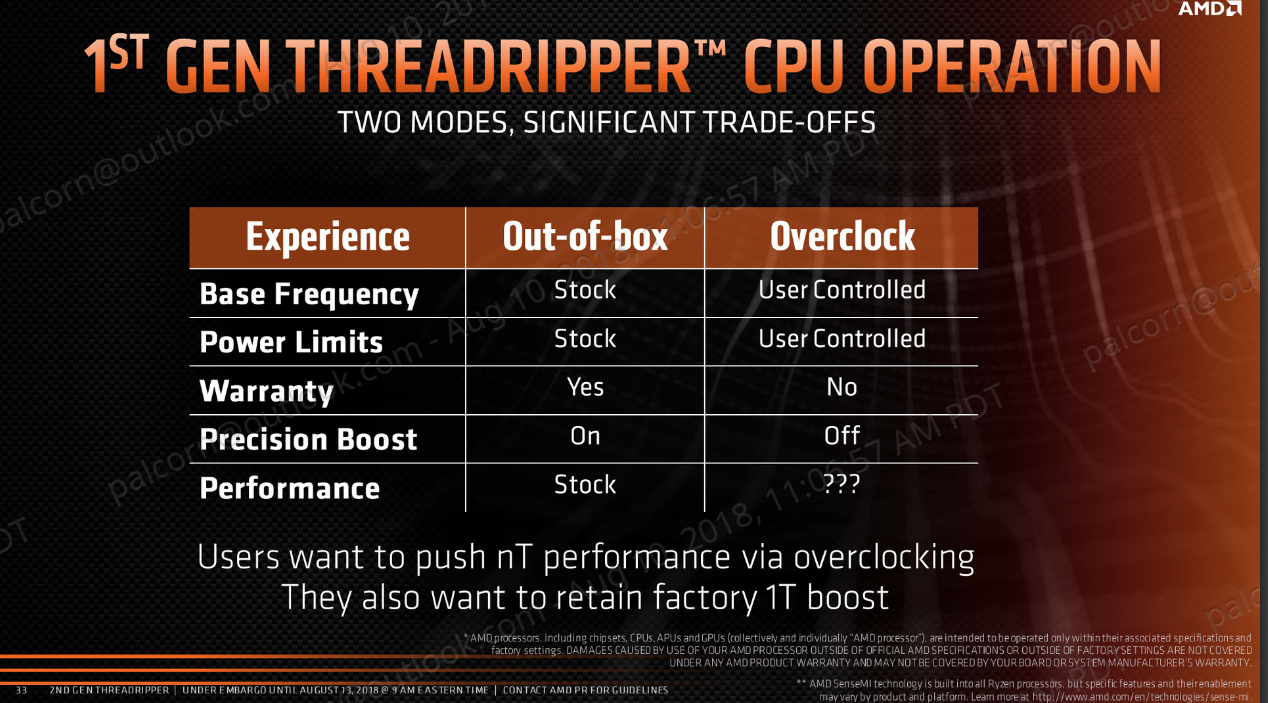
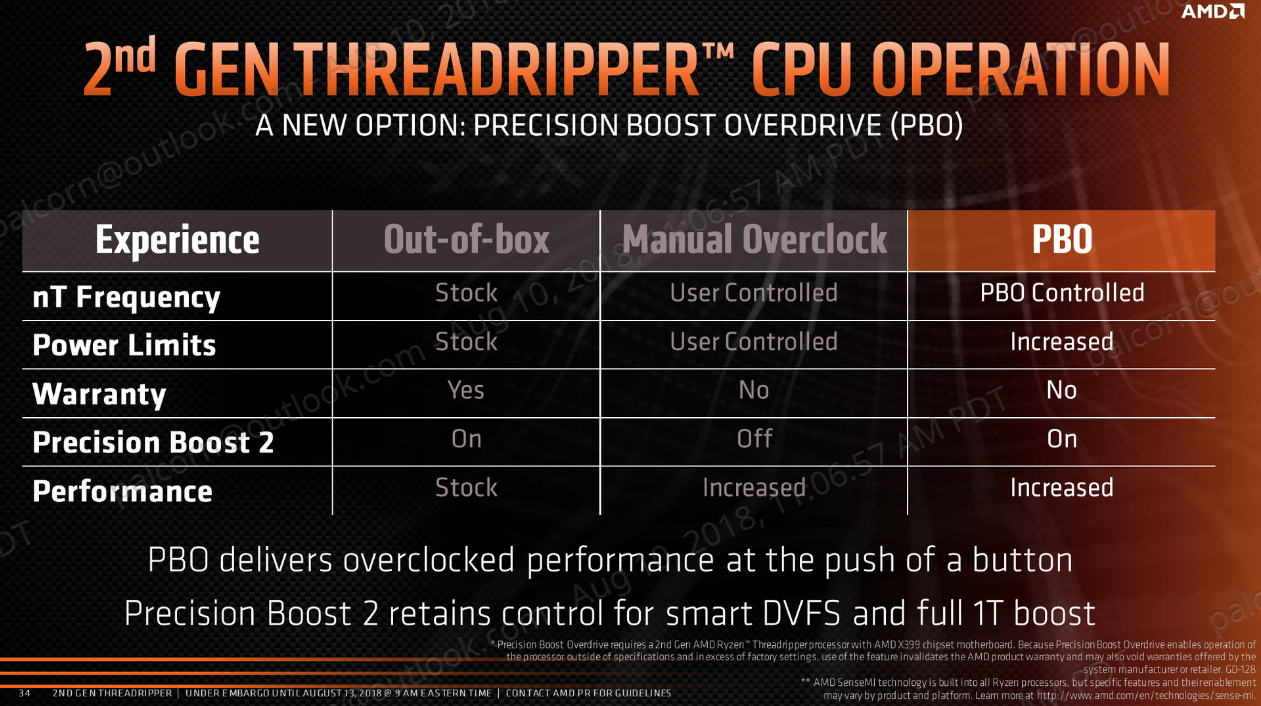
AMD's Ryzen Threadripper 2990WX and 2950X launch marks the official introduction of Precision Boost Overdrive (PBO), a feature that rolled out quietly alongside second-gen Ryzen CPUs earlier in 2018. PBO is an automated overclocking feature that boosts performance to the limits of a motherboard and cooler's capabilities. Cruelly, using it voids Threadripper's three-year warranty. And AMD unfortunately has no equivalent to Intel's optional Performance Tuning Protection Plan.
The new Threadrippers already push the frequency/voltage curve's boundaries at stock settings, so manual tuning often result in worse single-threaded performance because the silicon can't accelerate as aggressively under an all-core overclock. Locking the processor to a static frequency also prohibits it from downshifting into lower clock rate to save power at idle. PBO addresses the issues with manual overclocking head-on. It dynamically overclocks the processor and communicates with the platform to modulate performance based on what the motherboard's power delivery subsystem can do. AMD doesn't share a list of specific multi-core Precision Boost 2, XFR2, and PBO bins because the opportunistic algorithms achieve different frequencies based on temperature, current, and load.
All of the 2000-series Threadripper processors are technically backward-compatible with existing X399 motherboards. With that said, power delivery is an important variable to consider, given the requirements of 32 cores versus 16. MSI and Gigabyte both announced new X399 motherboards with beefier power delivery subsystems, while Asus introduced an add-on kit for one of its existing motherboards that improves VRM cooling.
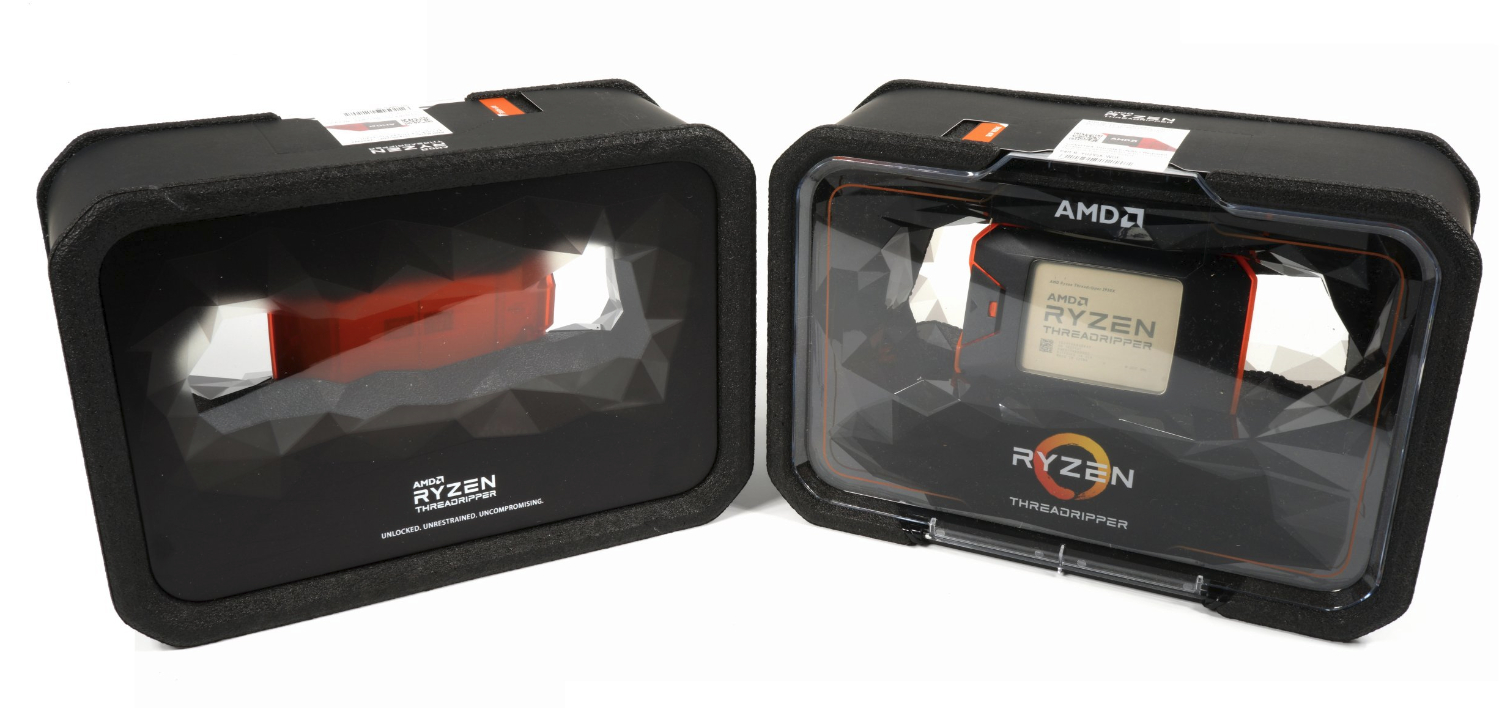
Part of the Threadripper package is, well, AMD's packaging. The original Threadripper box set a new bar for the industry (you can see our Threadripper 2 unboxing here), and the company stepped up its game with an even larger package this time around.
MORE: Best CPUs
MORE: Intel & AMD Processor Hierarchy - CPU Comparison with Benchmarks
MORE: All CPUs Content

Paul Alcorn is the Managing Editor: News and Emerging Tech for Tom's Hardware US. He also writes news and reviews on CPUs, storage, and enterprise hardware.
-
Rdslw first table is broken 32/64 cores/threads :)Reply
Ryzen Threadripper 2990WX
Ryzen Threadripper 2950X
Socket
TR4
TR4
Cores / Threads
16 / 32
16 / 32 -
philipemaciel Wow, while the 2990WX is a bit of a letdown, the 2950X is a nice surprise. Plenty of bang for your buck!Reply -
alves.mvc Why does Tom's Hardware stopped using the HPC benchmark? It was the most interesting measurement for me that work daily with finite differences and finite elements. Can you return to that?Reply -
totaldarknessincar Seems to me the best of both worlds continue to be Intel's 7900x which sells for $699 at microcenter. You get great gaming performance, and great multithreaded performance, and it's not 12-1800 bucks as some of these mega-threaded cards are.Reply
Despite all the fan-fare, it seems the 7980xe actually remains the best processor when overclocked overall.
Lastly for gaming, it's still 8700K or 8086 as best, with the 2700x from AMD being the best when you factor gaming and some multi-threaded stuff, while being very competitive price wise. -
feelinfroggy777 Very surprising performance from the 2950x. Almost enough to consider parting ways with my 1950x. Maybe when the pricing comes down some from the 2950x in a few months I will consider.Reply
The 2990wx on the other hand is a slight let down. Too bad they could not get the scaling down between the dies like they did with Threadripper 1. But I have read that was going to be an issue. Maybe AMD did not want the 2990wx to cannibalize their Epyc market.
With that being said, the 2990wx is still a modern marvel of technology, even more so when you consider the price. Only couple of years ago a CPU with less than a third of the cores cost just as much.
Competition sure is grand! -
basil.thomas Looks like Intel has an opportunity to bite AMD when they release their 28-core processor. I have a threadripper 2/x399 system but if I upgrade to the 2990wx, I will also upgrade the motherboard and the power supply as well. I think I may wait until the Intel 28 core comes out and see what kind of performance it delivers as I too notice running custom AI apps on the threadripper is barely faster than my old x99/6850 motherboard overclocked @ 4.3Ghz. I want max performance if I am going to pay over $1800 for the flagship which means core wars is just starting...Reply
MOD EDIT: watch your profanity -
ffleader1 Reply
Seem to me that you are mistaking best of both work with jack of all trade. No one who takes rendering seriously would want to sacrifice the performance for gaming. For that price, they may as well grab a 1950X. Sure you lose in gaming, but gain a huge jump in rendering. Also, I don't know about Microcenterbut it's still 1k on Amazon while 1950X is $850. 7900X is like a really really bad choice lol.21228046 said:Seems to me the best of both worlds continue to be Intel's 7900x which sells for $699 at microcenter. You get great gaming performance, and great multithreaded performance, and it's not 12-1800 bucks as some of these mega-threaded cards are.
Despite all the fan-fare, it seems the 7980xe actually remains the best processor when overclocked overall.
Lastly for gaming, it's still 8700K or 8086 as best, with the 2700x from AMD being the best when you factor gaming and some multi-threaded stuff, while being very competitive price wise.